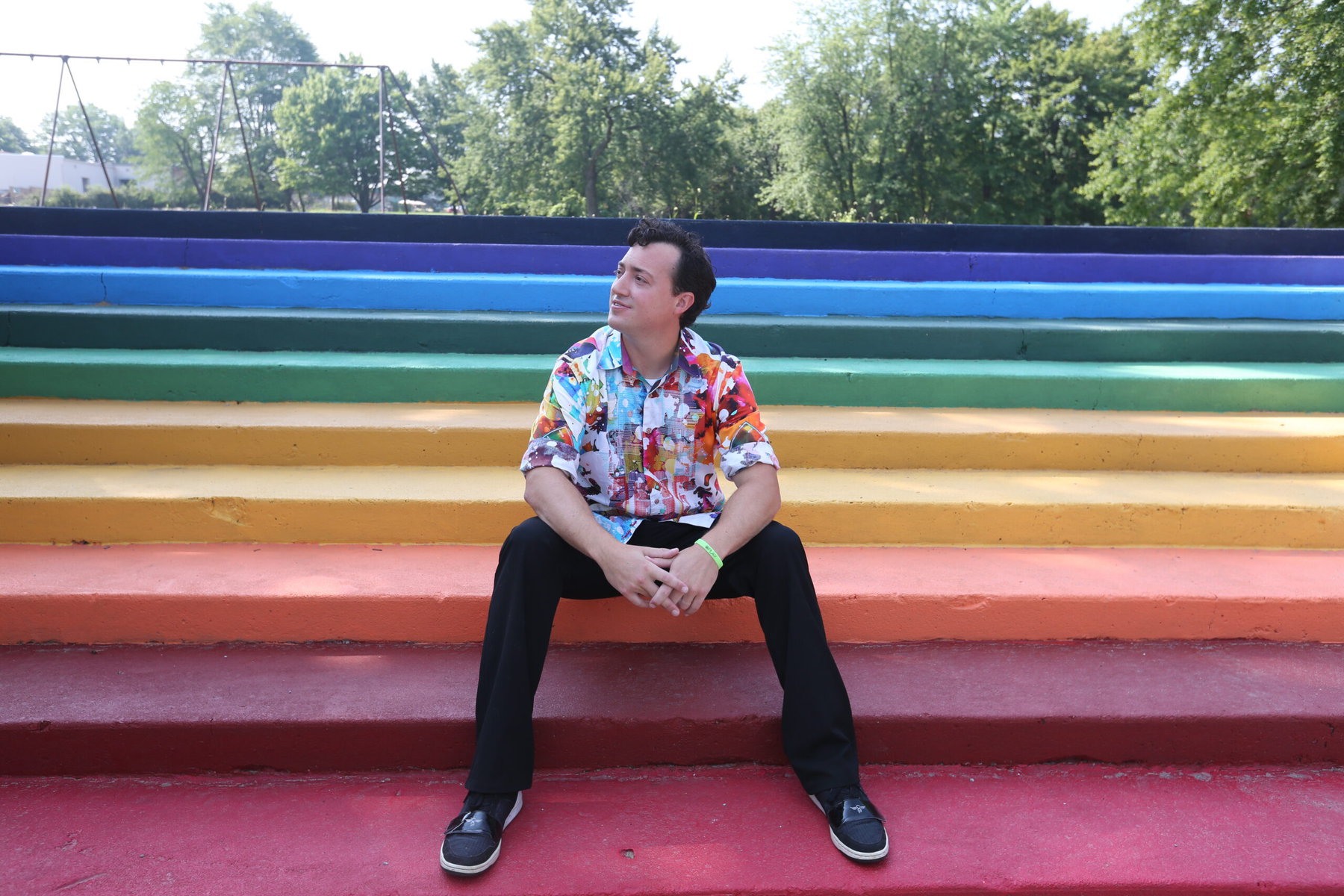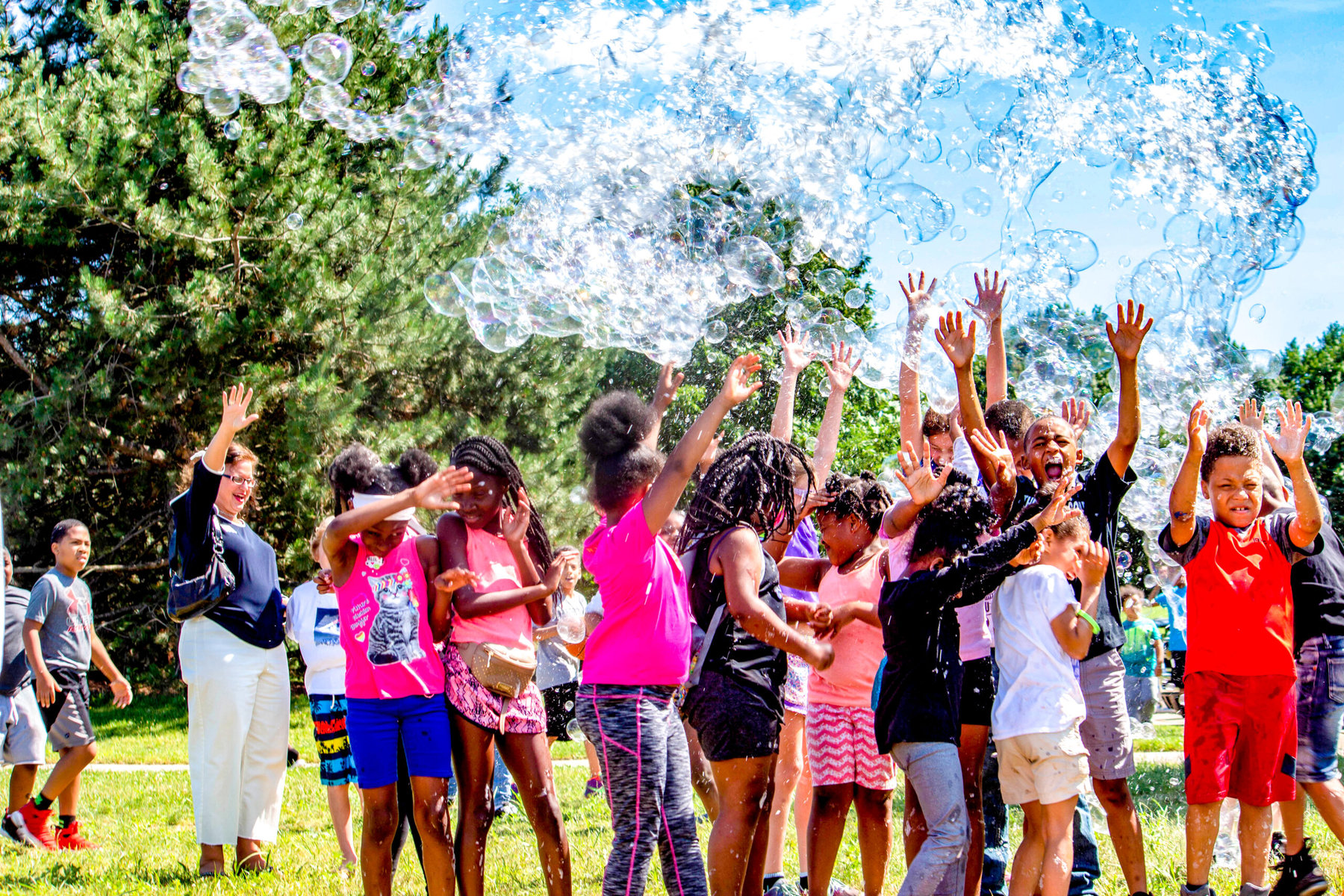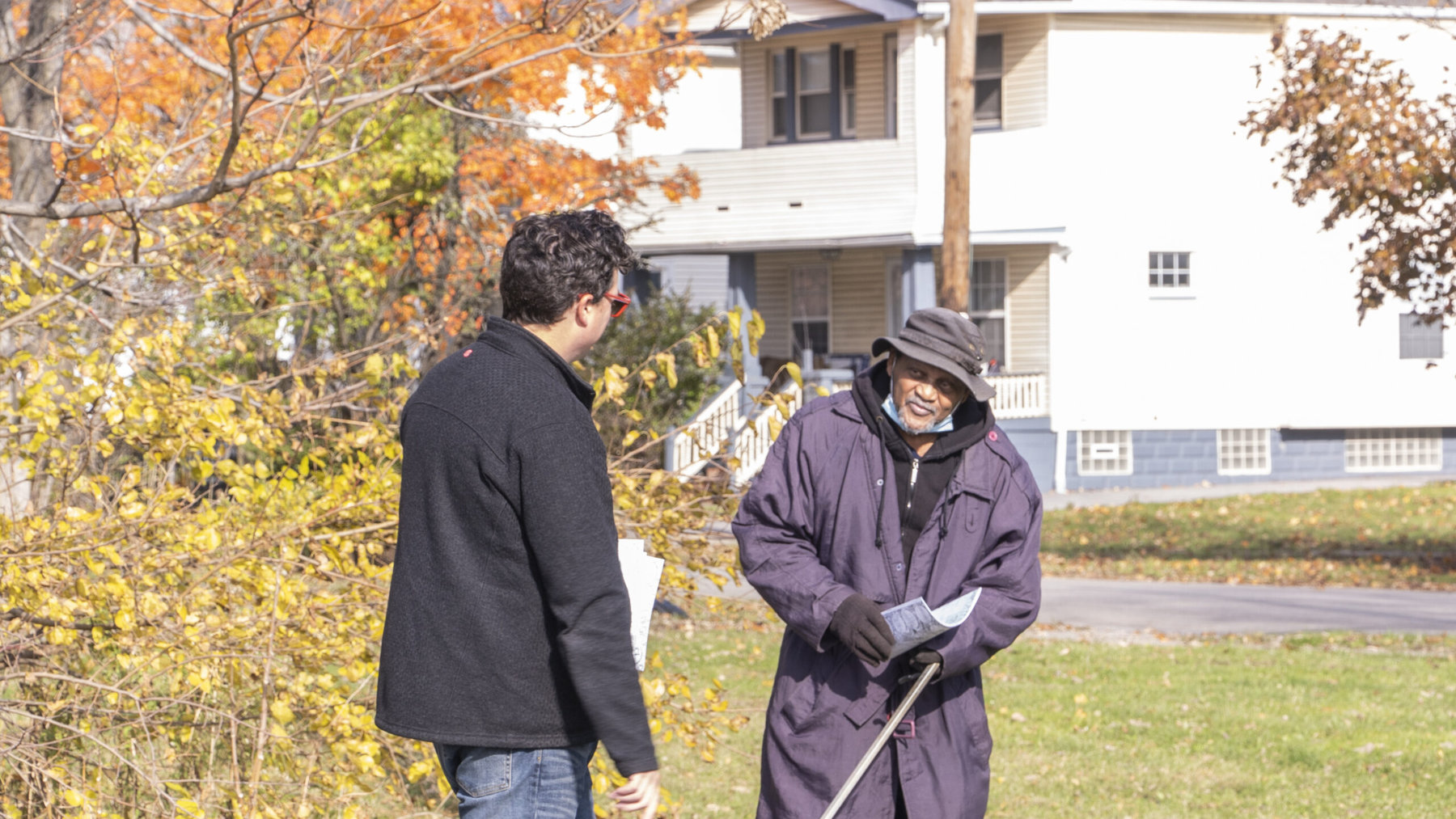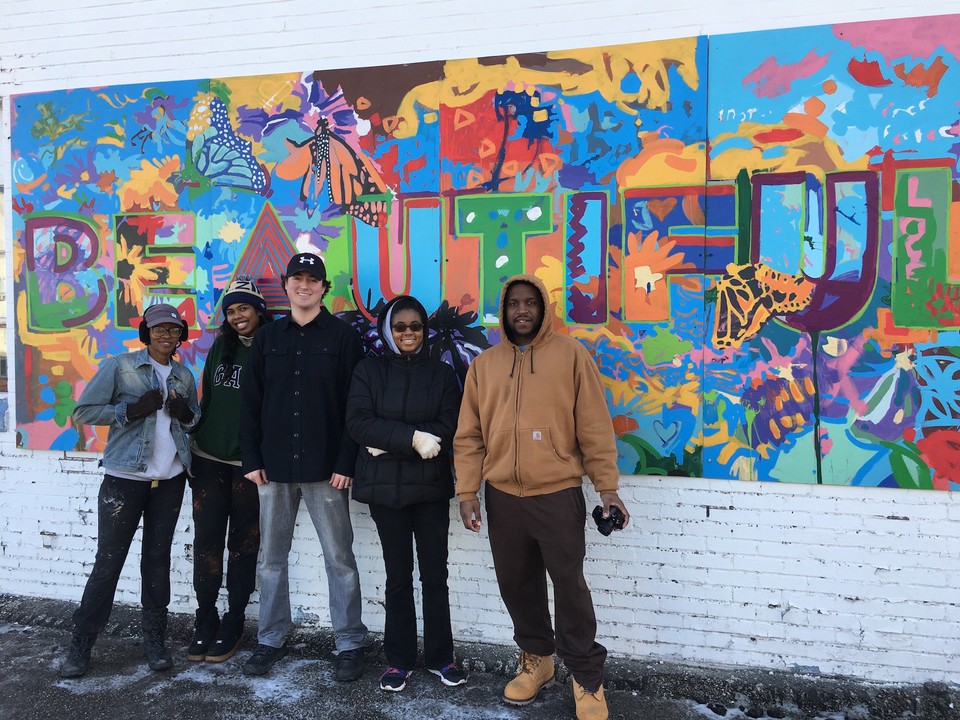Introduction, by Ben Speggen
In early July, three Our Towns team members – Jim and Deb Fallows and I – attended the Esri User Conference in San Diego. Jim wrote about his observations here. Our second piece of reporting to come from the conference is written by Our Towns Contributing Editor Alex Bieler.
This report grew from a session that Deb and I attended by artist Mac Love, the chief catalyst at Art x Love, a creative agency he and his wife, Allyse, launched in her hometown of Akron, Ohio.
Mac discussed his community engagement projects in the Buckeye-Shaker neighborhood in Cleveland. A century ago, Buckeye-Shaker was mainly Hungarian-immigrant. Now it is mainly Black. Mac Love’s projects used the Esri applications we’ve often discussed as a way of capturing citizen input—What was wrong with the neighborhood? What would help?—as steps to neighborhood renewal. Mac told the story of that experience and creating his “Steps to Equity” StoryMap, which you can see here. It is worth looking at in detail.
We were struck by the storymap technology’s user-friendliness, its ability to capture a lot of data to work with, and the potential to scale it up and out for many purposes to other communities. To get an ‘eyes-on-the-street’-level reporting, we turned to our Cleveland-based team member, Alex.
Alex and Mac take readers on a walking journey through the Buckeye-Shaker neighborhood, telling the story of change inspired by Mac’s own life-journey as an artist, the use of technology to capture citizens’ voices, and a glimpse of where this all can lead.
by Alex Bieler
As we drive through Cleveland’s eastside Buckeye-Shaker neighborhood, Mac Love pulls his 2013 Toyota Tacoma Double Cab over to the curb for a closer look at a vacant piece of land on Parkview Avenue.
“That’s exciting,” Mac tells me.
Mac, who didn’t grow up here, sees something that I, a Cleveland native who lives a mere 20 miles from this spot, hadn’t recognized or appreciated.
A hundred years ago, this was a Hungarian-immigrant part of the city. According to the 1920 Census, some 42,000 Hungarian-born people lived in Cleveland, the great majority of them in this neighborhood. Now the Buckeye-Shaker area’s population is less than 12,000, nearly 80% of whom are Black. Ineffective leadership and scarce resources led to population loss, litter in the streets, cracked sidewalks, and general neglect.
What Mac sees in that open space is a significant sign of progress. Wires that had once hung dangerously low are now gone. Where there had been piles of garbage and overgrown brush in Helen Simpson Park, is now a beautiful and inviting green space. Small changes, but positive changes, nonetheless.


Mac grew up around the world: New York, Belgium, Scotland, Japan. He says that this experience helped him learn that different places have different values, and how crucial listening was for communication.

From his earliest years, Mac observed the world and listened to the people as an artist. At 11 years old, he was drawing portraits for pay. In high school, he was a young intern-illustrator at Marvel Comics. In Scotland, he did performance art. In Connecticut, Banksy-style street art.
He returned to New York City in 2010 to work in branding. There he met his future wife, Allyse. Three years later, Mac and Allyse left New York for Akron, her hometown, to settle down, plant some roots, and start a family. That included the couple starting their own creative agency together, Art x Love, and wondering how they could become more engaged with the community they were now calling home.
“As an outsider, I enter into new environments with an extremely humble mindset and absorb as much as I can from the lived experience of others, and my own observations,” Mac tells me.
After a long process of considering prospects for funding, Mac eventually discovered a source of support, from the Knight Foundation. This foundation, which directs its philanthropy to cities like Akron that had been original sites of Knight newspapers, asked applicants in Akron: What is your best idea for the city? After more than 20 failed applications over several years, in 2017 Mac received one of two Knight grants issued to Akron that year for his art project that would help reduce divides in a diverse community. Totaling $241,000 (out of $5 million that went to 33 projects nationwide), it was the third largest amount awarded that year.
“We were proposing an alternative method where instead of investing heavy resources in a narrow corridor that increases people’s sense of disparity, we wanted to invest equally and find ways to make micro investments that stimulate positive change,” Mac says.
Thus, Art x Love launched @Play, a community-sourced template for change. The agency recruited Akron residents and University of Akron students to engage people on street corners, bus stops, and porches and to ask them about the history of each neighborhood, what challenges they faced, and the improvements they wanted to see.
The team interviewed 2,288 residents, explored 2,446 streets, and developed 93 community-inspired interactive art initiatives. It hired 168 local artists for more than 100 public art pieces, and refreshed more than 50 public areas, all with trusted community support.
“What we found out was that our approach was very novel – no one was really doing it like that,” Mac says. “We started to hear from city personnel and others that we had more intelligence and accurate information about what was going on than anybody.”

The success of @Play led to several more projects, including a walkability assessment in Akron’s University Park neighborhood. The assessment team walked every street and engaged with residents to gather information. This time, the team used the city’s ArcGIS account to record data and community feedback, geotag points of interest, and develop ideas for improvement in real time.
This was the first time Mac used the Esri-developed mapping software. This technology gave users an actual map of ways to improve the community, allowing the team to identify a series of opportunities ranging from adding artwork to identifying neglected buildings and areas in need of sewer repairs.
Following the success of @Play came a collaboration with John Carroll University’s Muldoon Center for Entrepreneurship on another resident-engaged walkability assessment. This time it would be of every street and sidewalk in Cleveland’s Buckeye-Shaker neighborhood, documenting the state of roadways, sidewalks, litter, greenery, structures, visibility, and perception of safety.
“People have for decades tried to figure out how to improve the lives of people in these communities,” Doan Winkel tells me. “I’m generalizing here, but they come in with agendas that they try to push onto them. It’s highly ineffective.”
Knowing that Doan, the founding director of the Donnelly School of Leadership and Social Innovation at John Carroll, was looking to support something different, a mutual friend introduced him to Mac.

The goal of the project was simple – to collect data and insights that could inform future investments and community projects. They added in a kind of qualitative element to the data entries, establishing some standard of guidelines for data input based on discussions and agreement among the surveyors, to try to reduce the subjectivity in their assessments.
Mac and his team of John Carroll students and Buckeye-Shaker community members also canvassed residents where they found them – on the street, at the grocery store, and in their front yards. These insights along with the findings from the walkability assessment led to a second project called The Village Activity Book, a 16-page interactive booklet to further encourage residents to share their ideas and connect to each other. The team distributed 3,000 copies aimed at inspiring potential future projects.

The process was a welcome change for residents. Having lived in Buckeye-Shaker for the past four years, Jennifer “Love” Carter had never experienced an opportunity for community input before. She was part of the walkability assessment this time, and she tells me that direct community engagement like this wasn’t just helpful, it was essential for success.
“We could have done this project another way where we didn’t engage with people at all, and it wouldn’t have been beneficial and the work wouldn’t have lasted,” Jennifer says.

Nearly two years and extensive data-collection into this project, the team is identifying projects to initiate in the near and long terms to impact the quality of life in Buckeye-Shaker, from fixing the hundreds of broken and uprooted sidewalks to creating a public art corridor near Shaker Square.
However, Mac says, “The truth is that capturing these insights is not enough. Our leaders need to make more informed decisions and investments that will have an enduring impact on these communities.”
Bringing data to life somehow with stories, visuals, and spreading the word widely should help realize the next steps. When Mac looks at the neglected sidewalks uprooted by trees, he imagines people in walkers and electric scooters forced to travel on the road and laments that construction on Buckeye Road has made accessibility for these citizens even more challenging than it was even at the start of the assessment.
There are signs of improvements. More residents and local groups have organized neighborhood cleanups, added new murals, and planted trees along Shaker Boulevard. John Carroll University is also in the process of signing contracts to back projects outlined in the “Steps to Equity” effort that the community has identified it needs, as part of the their ongoing commitment to significantly partner with the Buckeye-Shaker neighborhood.
“We want to see those benefits go to the most places in the shortest amount of time possible,” Mac says.
Sometimes it takes an artist to see a vacant lot as a canvas of improvement. Other times it takes engaging a community to help paint their own picture of a better future. Akron and Cleveland are demonstrating both opportunities.




